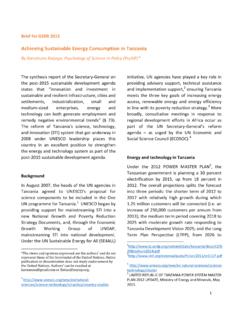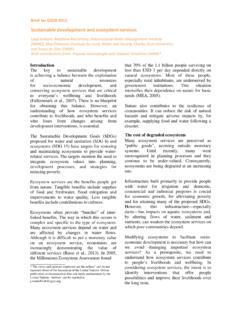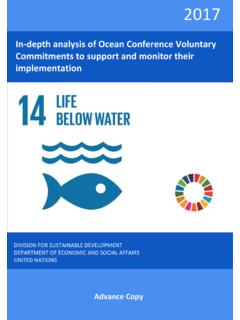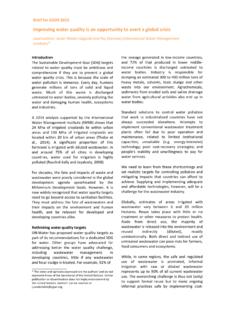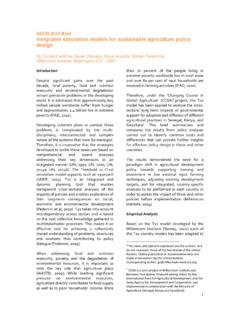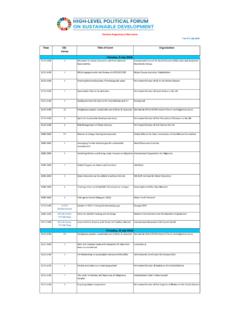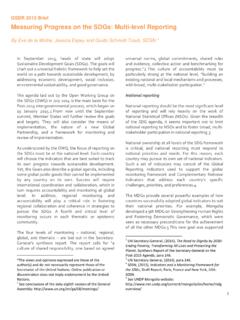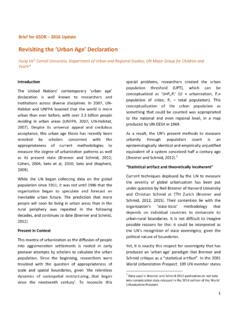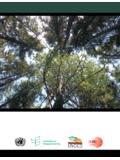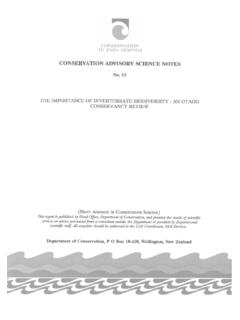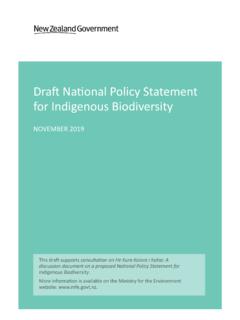Transcription of Biodiversity at the Heart of Sustainable Development
1 1 Biodiversity at the Heart of Sustainable Development Input to the 2018 High-level Political Forum on Sustainable Development (HLPF) Secretariat of the Convention on Biological Diversity (CBD) 27 April 2018 Introduction Biodiversity the diversity of life on Earth is defined as the variability among living organisms from all sources, including diversity within species, between species, and of ecosystems. Biodiversity thus includes not only the millions of different species on Earth, it also consists of the specific genetic variations and traits within species (such as different crop varieties), as well as the various types of different ecosystems, marine and terrestrial, in which human societies live and on which they depend, such as coastal areas, forests, wetlands, grasslands, mountains and deserts.
2 Biodiversity is essential for Sustainable Development and human well-being. It underpins the provision of food, fibre and water; it mitigates and provides resilience to climate change; it supports human health, and provides jobs in agriculture, fisheries, forestry and many other sectors. Without effective measures to conserve Biodiversity and use its components in a Sustainable manner, the 2030 Agenda for Sustainable Development will not be achievable. Given the need for Biodiversity and healthy ecosystems to achieve the 2030 Agenda, it is not surprising that many Sustainable Development Goals (SDGs) include targets that reflect their important role. The role of Biodiversity and healthy ecosystems is thus reflected not only in SDG 14 (life below water), and SDG 15 (life on land), but also in many other goals and targets.
3 For example, there are critical Biodiversity dependencies for SDG 2 on zero hunger. Target calls for a doubling of agriculture production and, according to the Thematic Assessment of Pollinators, Pollination and Food Production of the Intergovernmental Science-Policy Platform on Biodiversity and Ecosystem Services (IPBES), more than three-quarters of the world's food crops rely at least in part on pollination by insects and other animals, with between US$235 billion and US$577 billion worth of annual global food production relying on direct contributions by An analysis of how Biodiversity supports the achievement of all SDGs, published jointly by the Secretariat of the Convention on Biological diversity (CBD), the Food and Agriculture Organization of the United Nations, the World Bank, the United Nations Environment Programme, and the United Nations Development Programme, is available In the context of the SDGs to be reviewed by the 2018 High-level Political Forum on Sustainable Development , Biodiversity supports the achievement of the 2030 Agenda in the following ways: 1 2 2 SDG 6: Clean Water and Sanitation.
4 Ecosystems provide reliable sources of freshwater. Ecosystems also function as natural water infrastructure, costing less than technological solutions. For instance, wetlands regulate flooding, and healthy soils increase water and nutrient availability for crops and help reduce off-farm impacts. UN-Water underscores the importance of nature-based solutions in water management in its flagship report, The United Nations World Water Development Report 2018: Nature-Based Solutions for SDG 7: Affordable and Clean Energy. Bio-energy produced from renewable biomass such as forestry by-products and agricultural residues can provide major opportunities for supplying cleaner and affordable energy. Ecosystem services are also important for clean energy, , the sources of water needed for energy production.
5 SDG 11: Sustainable Cities and Communities. Ecosystems help secure freshwater supplies on which cities rely, and can provide natural solutions for urban water run-off, regulating temperature, supporting clean air, and providing resilience to climate change and natural disasters. SDG 12: Responsible Consumption and Production. Utilizing more resource-efficient approaches is an essential aspect for the Sustainable use of Biodiversity . Reducing wastes and pollutants is also an important element to reduce adverse impacts on Biodiversity . SDG 15: Life on Land. The conservation, restoration and Sustainable use of terrestrial ecosystems is essential for Sustainable Development and for achieving the 2030 Agenda and all of the SDGs.
6 Targets under this goal include a call to integrate ecosystem and Biodiversity values into national and local Development planning, poverty reduction strategies and accounts (Target ). Other targets highlight the importance of particular ecosystems, including wetlands, forests and mountains, while others focus on specific challenges, such as desertification and land degradation, as well as poaching and trafficking of protected species. Despite these important roles in Sustainable Development , Biodiversity and ecosystem services which support people s lives and livelihoods continue to be degraded and lost at unprecedented rates. The recent regional assessment reports by the Intergovernmental Science-Policy Platform on Biodiversity and Ecosystem Services (IPBES) found that Biodiversity is in decline in all regions of the The Strategic Plan for Biodiversity 2011-2020 and its twenty Aichi Biodiversity Targets, adopted by the Conference of the Parties to the Convention on Biological Diversity (CBD) in 2010 at its tenth meeting5, has been recognized by the United Nations General Assembly as the global policy framework for Biodiversity .
7 Accordingly, many elements of the 2030 Agenda and its SDGs have been drawn from the Strategic Plan and the Aichi Biodiversity Targets. The Strategic Plan for Biodiversity 2011-2020 itself is framed in the context of Sustainable Development , with a vision of maintaining and enhancing ecosystem services, sustaining a healthy planet and delivering benefits essential for all people. At its thirteenth meeting, held in December 2016, the Conference of the Parties to the Convention welcomed the adoption of the 2030 Agenda for Sustainable Development (see decision XIII/3, para. 3)6 and recognized the strong interdependence between the Strategic Plan for Biodiversity 2011-2020 and the 3 4 5 6 3 SDGs in which Biodiversity is included in numerous goals and targets (para.)
8 9). In addition, it recognized that the implementation of the 2030 Agenda provides a major opportunity for the mainstreaming of Biodiversity and for the achievement of the Aichi Biodiversity Targets ( ). Further, the Conference of the Parties called for an integrated approach to the implementation of the strategies and plans for the 2030 Agenda and of national Biodiversity strategies and actions plans (NBSAPs; paras. 14 and 15). Leave No One Behind The full enjoyment of human rights, including the rights to life, health, food and water, depends on the services provided by ecosystems. The provision of ecosystem services depends on the health and sustainability of ecosystems, which in turn depend on Biodiversity . The full enjoyment of human rights thus depends on Biodiversity , and the degradation and loss of Biodiversity undermine the ability of human beings to enjoy their human rights.
9 (UN Human Rights Council, 34th Session) In the context of the 2030 Agenda s leave no one behind principle, the Convention s Aichi Biodiversity Target 2 is that, by 2020, at the latest, Biodiversity values have been integrated into national and local Development and poverty reduction strategies and planning processes and are being incorporated into national accounting, as appropriate, and reporting systems. 7 Additionally, at its twelfth meeting, the Conference of the Parties to the Convention on Biological Diversity adopted decisions encouraging Parties to: (3)..integrate Biodiversity and nature s benefits to people, including ecosystem services and functions, into poverty eradication and Development strategies, initiatives and processes at all levels, and vice versa, to integrate poverty eradication and Development concerns and priorities into national Biodiversity strategies and action plans and other appropriate plans, policies and programmes for the implementation of the Strategic Plan for Biodiversity 2011-2020 and the achievement of the Aichi Biodiversity Targets, and to monitor, evaluate and report on these integration efforts, through appropriate indicators and tools, and include this information, inter alia, in their national (5).
10 Enhance the contribution of Biodiversity to Sustainable Development and poverty reduction through the fair and equitable sharing of benefits arising from the utilization of genetic resources and associated traditional knowledge, the conservation of biological diversity and the Sustainable use of its components. 8 Furthermore, the 34th Session of the Human Rights Council recognized that although the importance of a healthy environment for the enjoyment of human rights is widely recognized, the relationship between human rights and Biodiversity remains less well understood and, from the perspective of leaving no one behind, made the following observations related to biodiversity9: The loss of Biodiversity -dependent ecosystem services has disproportionate effects on people who are vulnerable for other reasons, including gender, age, disability, poverty or minority status.

